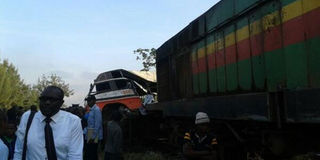11 dead in train-bus crash in Nairobi

The scene of the train-bus crash in Nairobi's Mutindwa area. Photo/KENYA RED CROSS
(VIDEO: Train rams bus at Mutindwa)
At least eleven passengers have died after a Dandora-bound train hit a bus at an unmanned level-crossing at the Mutindwa stage in Nairobi's Buruburu area Wednesday morning.
Scores of other passengers were injured when the train rammed the Umoinner bus that was heading to the city centre from Umoja. The 33-seater bus also hit a private saloon car, injuring the occupants.
The Kenya Red Cross it received 34 casualties who were rushed to Mama Lucy Hospital. Five were admitted to the hospital while two others were treated and discharged.
17 of the injured were transferred to Kenyatta National Hospital for specialised treatment and two others were taken to MP Shah Hospital within the city.
According to the Kenya Red Cross, seven died at Mama Lucy Hospital, one succumbed while being transferred while three died at the scene of the accident.
Eyewitnesses said the train driver survived the accident and immediately rushed to the nearby God's Last Appeal Church. He knelt down to pray but appeared to have been in shock, one of the worshippers at the church said.
Rift Valley Railways chief executive officer Darlan David said they are carrying out investigations and collecting information from police to ascertain what happened.
"We are going to carry out proper investigations in collaboration with the police to find out what could have happened. However, wherever there is a level crossing, the rule is that all traffic be held for the approaching train," he said
TEMPORARY STRUCTURES
The temporary structures constructed along the railway line at the crossing near Mutindwa market make it difficult for the drivers to see approaching trains at the crossings.
The structures are still there despite the government’s earlier plan to conduct large-scale eviction of people living and operating businesses along the railway lines.
The government had planned to also undertake large-scale demolition of structures that purportedly present a risk to the occupants of railway line operational corridors and households living near or under electric power lines and way-leaves or are in the way of planned bypass roads.
Those to be affected most were hundreds of thousands of people living in informal settlements such as Kibera, Korogocho, Agare, Lunga Lunga, Sinai, and Soweto.





